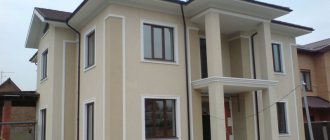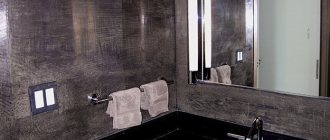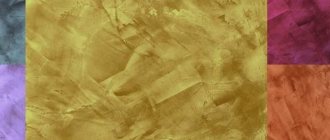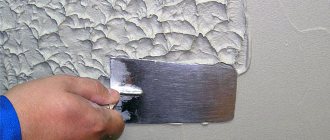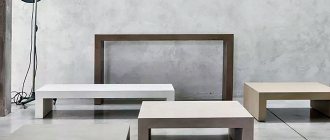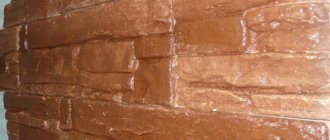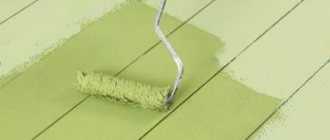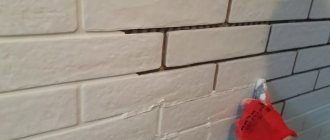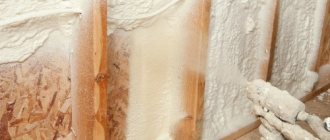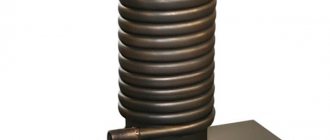When performing repair and finishing work, special attention is paid to creating interior design. Various materials and coatings are used to decorate walls. The most popular among the known options are decorative plasters.
One of the varieties of such options is decorative plaster, which creates the effect of stone on the wall. When using this material, a coating is created on the wall that imitates decorative stone. To create a stylish and unique design, you should study the features of choosing a material, as well as learn about methods of applying the composition to wall surfaces.
Do-it-yourself imitation stone from plaster: photos and videos
A “stone” wall can be imitated with plaster.
The method consists of creating a special texture of the coating, its colors, and squeezing out the relief. Imitation of stone for interior decoration is carried out using any composition - concrete, gypsum, lime, clay plasters. Both special mortar compositions (branded plaster mixtures), which have the most successful combination of ingredients, and ordinary cheap putties are used.
Techniques for creating plasters in the form of stone are divided according to the depth of elaboration of the pattern.
Smooth plaster, imitation of natural stone - marble, granite, polished stone slab (for example, Venetian plaster). Such coatings are made as smooth as possible, covered with a wax composition, and polished. The wall turns out perfectly smooth, glossy or semi-matte.
The pattern is obtained by mixing differently colored plaster solutions or painting the surface.
Textured.
The walls are made as if from large solid stone (limestone, sandstone, etc.). The plaster has a pleasant, rough surface, similar to stone. Imitating stone with your own hands using this technique is the most accessible, since the work is simple and the effect is easily achievable.
Textured “stone” plasters come with a fine pattern and are quite convex. The nature of the surface depends on what material is ultimately desired.
Flat-relief.
Plaster with a stone texture can be designed like stonework. In this case, the development of seams may not be very deep, indicated by a small groove.
Flat-relief plasters are more suitable for simulating processed stone, stone blocks, and bricks. There are no deep grooves or depressions on such a wall; it is flat.
Creating such a coating with your own hands is a little more difficult, since the ability to draw believable masonry is important. But it’s not difficult to imitate a wall made of even blocks. Imitation of stone on a wall in the form of three-dimensional masonry, 3D plaster
More difficult to implement by an amateur: it requires the application of significant volumes of solution and layer-by-layer painting.
Imitation of stone on the wall in the form of three-dimensional masonry, 3D plaster. More difficult to implement by an amateur: it requires the application of significant volumes of solution and layer-by-layer painting.
It is easier to make three-dimensional plaster with your own hands if you use special molds (impressions) that allow a worker who is not inclined to draw to obtain a believable drawing. But you have to buy prints, which leads to additional costs.
Plastering work requires knowledge, backed up by skill and experience. However, a beginner can learn simple techniques to achieve success. At least when renovating your own home.
Laying stone - step by step instructions
Laying decorative stone with your own hands begins with calculating the required amount of this stone. We multiply the area of that part of the walls that will be finished with brick or stone facing tiles in the apartment by 1.1, i.e. we give a reserve of 10% for trimming and rejecting the material.
Step 1 preparing glue
Pour the adhesive composition into a bucket and, having read on the label how to prepare it correctly, add water and mix thoroughly with an electric drill with a mixer attachment. Let it sit for 5 minutes, then repeat the operation. As a result, the glue should acquire the consistency of thick sour cream.
Step 2 laying the first row
Laying the first row can start from the floor, or from the ceiling. It is believed that when laying from the floor, the tiles following the first row, having support, will not slide down the wall. If you lay it from the ceiling, the solution falling from the spatula and tiles will not stain the tiles laid below. Both are correct. Using a notched trowel, apply the adhesive solution to part of the wall. The thickness of the glue layer should be about 7-8 mm. Press the appropriate number of tiles. Carefully level them to the building level. Then repeat until the first row ends. Subsequent rows must be laid so that the distances between the rows are the same, the width of the vertical seams must also be uniform. This is achieved by using plastic dividers in the shape of a cross. After the masonry has dried, the delimiters are removed. Another important point: vertical seams in adjacent rows should not coincide, that is, one should not be a continuation of the other.
Step 3: finishing the corners
Particularly often, corner cladding has to be done when finishing the front door with decorative stone, which, if the work is done “with your own hands,” can create difficulties for an inexperienced performer. If the stone is made in the form of tiles, the corner can be made in two ways: with dressing according to the pattern of brickwork, and with cutting the end of the tile at an angle of 45°. Trimming is done with a grinder or on a tile cutting machine. It is easier to finish a corner if the purchased decorative stone contains special corner elements.
Step 4: decorating the edges of the masonry
The expressiveness of decorative stone comes from the correct design of the edges. A possible option is to trim the free edge of the stone and then sand it with sandpaper.
Step 5 sealing joints
The joints between the stones are sealed with the same glue on which the tiles were laid. A budget option is to use gypsum putty. The sealing is carried out using a construction syringe, vaguely reminiscent of a pistol. The adhesive solution is squeezed into the space between the stones. Excess is removed with a spatula and a damp cloth.
Step 6 finishing
Finishing refers to the tinting of joints if the composition used differs from the color of the stone. It is advisable to cover the masonry with two layers of acrylic varnish. This will make it strong and durable.
Using plaster varnish
Standard plaster products are grayish or white, and painting them or tinting them with a colored varnish will help give the wall the desired look. With its help, you can design the surface in an original way and stylize it in accordance with the chosen direction in the interior. Varnishing helps increase moisture resistance, because gypsum products deteriorate when in contact with moisture. After varnishing in several layers, the decorative stone will be suitable even for finishing wet rooms. Also, applying varnish reduces the susceptibility of the tiles to impact.
Varnish for gypsum decorative stone: types
There are varnishes of different types, compositions, with different characteristics and properties on sale.
Shellac varnish
This type is usually used in decoupage, but it is often used in finishing work. Shellac is alcohol-based, so it works well with plaster. It can be applied as a stand-alone coating or over any paint. Shellac creates a thin polishing layer that looks stylish and very attractive.
The composition can be transparent and colored. There are even special varnishes with an aging effect that are used to give the base a vintage look. If you combine the product with rosin in a 1:1 ratio, a protective film will be created on the surface of the plaster, eliminating the appearance of dirt and giving the wall a marble look.
Acrylic varnishes
Acrylic-based varnishes perform a decorative and protective function. They are moisture resistant, do not deteriorate from household chemicals, ultraviolet radiation, temperature changes, dry quickly, and do not have a pungent odor. When thickening, acrylic varnish can simply be diluted with water.
In appearance, acrylic coatings can be matte, semi-matte, or glossy. Matte ones help give the stone the appearance of a natural, rough material. Semi-matte varnishes work in a similar way, only their transparent varieties may leave a slight light coating after drying. Glossy products shine and lead to glare, which must be taken into account when planning the decor in the room.
Oil varnishes
Oil varnishes contain artificial resins and plant extracts. After application to the gypsum stone, a thin film is formed, protecting the material from any external factors and extending its service life. Oil-based varnishes can be transparent or colored, glossy or matte. After this product has dried, the surface of the decorative stone will look a little darker than initially.
Yacht varnishes
The most durable, long-lasting and reliable varnish for stone is considered to be yacht varnish. It has a high degree of water resistance, making it suitable even for handling yachts. Contains solvents, has an unpleasant odor and is more suitable for outdoor use, although after complete drying it ceases to be toxic. For maximum surface protection, yacht varnish is applied in 2 layers.
Varnishing rules
Before applying the coating, you need to make sure that all elements have dried well after priming or protective hydrophobization. The adhesive to which the decorative stone was attached must also dry out, otherwise the integrity of the cladding may be compromised.
Tips for varnishing stone:
- rough parts should be sanded before spraying varnish; fine-grain sandpaper is well suited for this purpose;
- if impregnation was applied to the stone, you need to read the instructions for it and clarify the possibility of subsequent varnishing and compatibility with a particular varnish;
- shiny compositions reduce the effect of the naturalness of the stone, so for country styles, Provence and other styles striving for naturalness, it is better to choose matte products;
- Before varnishing, be sure to wipe off all dust from the stone;
- during work, do not wet the wall or elements - they quickly absorb moisture;
- The most convenient method of varnishing is spraying from a spray gun or airbrush.
By using your imagination, you can use decorative stone to find very interesting solutions even in a small apartment. This material looks unusual, fresh and gives the house a special flavor, fills it with warmth and comfort.
Methods of jointing and invoicing
After drying, cement plaster becomes granular and finely porous, which is not entirely natural for most types of rocks. Removing texture and applying jointing is the most creative and delicate part of the finishing process, which determines the believability of the appearance.
It is required that the surface acquires some semblance of a glossy film, which is possible by squeezing a small portion of dissolved cement onto the surface. The best way to achieve this effect is to spray the freshly applied solution with a small portion of water and cover the surface with a film about 10–15 microns thick. The film is laid on the surface and rolled with force with a hard roller, without smoothing out the folds. At the same time, through the transparent shell it is clearly visible how laitance accumulates on the surface.
Popular articles Has your economy lamp burned out?
Stage one: marking and texture
For work, use finishing or starting putty. If the surface requires a grain size that is different from the starting putty, then it is better to use it. This solution is more suitable for imitation, despite the fact that additional texture will be created. If you need to depict a facing brick, use a finishing putty that provides a perfectly smooth surface.
A layer of mortar 0.5 cm thick is applied to the wall and distributed evenly. Immediately create a rough surface. To do this, use simple materials:
- foam sponge,
- hard bristled roller,
- hard fabric folded into a ball
- steel wool for cleaning kitchen utensils.
With short, jerky touches, they leave marks on the wet putty, filling the prepared area with them. This technique gives the surface the realism that is characteristic of rough natural stone.
Advantages of stone plaster
The popularity of stone plaster must be justified in some way: after all, it is extremely popular among people of various social statuses, ages and even tastes.
So, what are the advantages that make people choose this method of finishing their home?
- Relatively low price. There are immediately two sides to this issue: people who believe that plaster is quite expensive, and people who disagree with this. In principle, both sides are right to some extent. One thing can be said: compared to the original natural stone finish, stone plaster seems really cheap.
- High quality workmanship. This is one of the reasons why decorative plaster seems so expensive: it is made of really high quality, and is suitable not only for people with low or average income, but also for people for whom the price of the product does not play a big role.
- You can make stone plaster yourself. Yes, you can even make it yourself: the main thing is to have all its ingredients, tools and some knowledge.
- A huge selection of different types of plaster. Since it is created by human hands, at the moment there are a large number of types of this plaster mixture that imitate a variety of rocks. The choice is huge: from ordinary marble to exotic rocks that will surprise even the most experienced designers.
- The ability to use some types of decorative plaster for exterior decoration, facade finishing or foundation. The most expensive options for decorative plaster mixtures are impervious to the influence of moisture and direct sunlight, which allows them to be used for exterior decoration.
If you pay attention to the price-quality combination, then decorative plaster has almost no disadvantages: but this does not mean that it is worth purchasing inexpensive options. If you have the opportunity to spend a little, then it’s worth doing it: in any case, if you purchased plaster in a company store, then after you see the result, you will not regret it
Making a form for filling
First of all, the front side is, of course, important for tiles. It is formed by the base or bottom of the mold. The side formwork or sides of the form prevent the gypsum from leaking out and ensure the required dimensions.
The simplest form is needed for smooth tiles. To do this, we use glass as a base. Since we are not talking about production on an industrial scale (at least while we are just learning), window glass, or even better, display glass with a thickness of 4-6 mm, will do.
I recommend: How to make a wooden floor using joists with your own hands
A large sheet is inconvenient; it is better to make several forms, each for two 25x25 cm tiles.
We carefully round the edges of the glass with a diamond file so as not to cut yourself. To prevent the glass from breaking, we will make a base for it from thick plywood, OSB or a similar material.
Now you need to make the sides. Their height should correspond to the thickness of our tiles.
Let's take pine bars 10x15 mm. For one mold you need two bars 60 cm long, two 30 cm and one 25 cm.
Important!
Gypsum sets quickly, and its crystalline structure is completely formed within half an hour. But the tile will only have full strength when it is completely dry. Thin plates in their raw form are brittle and inconvenient to work with, so you should not make tiles thinner than 10-12 mm.
We cover the bars with waterproof varnish or drying oil. Using thin screws, we attach strips of galvanized steel 0.75-0.8 mm at the ends of each bar, so that they protrude by 23 mm.
Stepping back 15 mm from the ends of the bar, we bend the ends of each strip with the letter “G”. We bend the end not at a right angle, but a little stronger. We will use these “hooks” to connect the bars to each other. By moving the bars, we get tiles of various sizes (see Fig. 1). This design expands in one direction, and the movable jumper allows you to make tiles of almost any size.
Composition of types of plasters
Having chosen the desired design of the room in which you plan to imitate masonry, you need to be no less careful in choosing the type of plaster.
- Mineral based material.
The lime component is the main component in this mixture. Additionally included minerals, colored clay, stone chips. The advantage of such plaster is that time will only enhance the stability of the material, which will not be destroyed by ultraviolet radiation and water evaporation. If renovations are planned in a damp room, choose this option. Expensive compared to others. And you need to take into account the low elasticity and the fact that there will be difficulties in ensuring adhesion to the wall surface.
- Acrylic. Another name is polymer plaster. The binding material in the composition is acrylic resins. Good for use on the floor. Successfully resists exposure to sunlight, sudden temperature changes, and moisture. Vaporproof.
- Silicate. Based on organic silicon. It has good ductility and is vapor-tight. Resistant to dirt. But in the construction market the choice of color palette is limited.
- Silicone. The base and binder is silicone resin. Extremely resistant to aggressive environments, exposure to sunlight, hydrophobic and vapor-tight. The color range from which you can choose is wide. Considering the plasticity of the material, this type of plaster will perform well when creating relief surfaces.
Cost of plastering finishing works
The price for the services of professional craftsmen is ultimately more expensive than the materials purchased for wall decoration. This is not surprising, since the work of builders is highly valued.
The price for the work will be per square meter. Wall decoration with decorative plaster can be ordered cheaper from private craftsmen working without the mediation of construction companies. Private traders rarely give a guarantee for work; even reviews help little.
When paying professionals, they order a labor-intensive type of plastering and complex reliefs. It is not in the interests of builders to delay the completion of work, which has a positive effect on the speed of repairs. Imitating stone from plaster with your own hands will take much more effort.
The “stone-like” interior effect for everyone implies an individual vision of design. Rough brutal surfaces of the castle wall, or delicate brickwork, bright red shades, muted brick, or inconspicuous beige. There are a huge number of options for both textures and color palettes. But even an amateur designer will choose the right option for any room.
Areas of use
The possibilities for using the material are very wide. Designers offer a lot of options for finishing not only walls, ceilings, but also other surfaces with gypsum tiles. Gypsum decor is found in private homes, offices, shopping centers and other public institutions. The material decorates smooth wall panels, columns, fireplaces, niches, bay windows, and arches well. Such finishing, in the right tone, can diversify the interior design and add solidity, warmth and charm to the room.
When choosing a color spectrum, you need to remember that light shades visually expand the space, while dark shades conceal it. Decor of different shades will help to zone the room, and the thinness of the tiles will not “steal” extra centimeters from the surfaces of the walls and ceiling, and the lightness of the weight does not require the construction of a solid frame.
Finished with tiles:
- walls;
- ceiling;
- window slopes;
- fireplaces;
- spans;
- steps;
- doorways;
- columns and other surfaces.
Before you start making gypsum tiles at home, it is important to consider that the production of decorative gypsum tiles does not require sophisticated equipment, but it is better to select in advance the shape, format and shades of the material that are suitable for the room being restored.
Technology for making decorative tiles at home
Tips for using decor:
- You cannot glue the material to a base that changes shape under the influence of external factors (plywood, chipboard).
- The permissible humidity limit for the use of cladding is 75%.
- If glue gets on the outside of the tile, the lining will turn yellow.
- When laying out the material, be sure to grout the seams with extreme caution; the grout should not get on the front side, because it will be difficult to remove the grout.
The finished material is laid on the surface at a temperature from +10 to +40°C, but it is better to start the jointing process at least 24 hours after installation of the coating.
Preparatory stage
- remove old finishing material;
- carefully scrape off all the scraps that, one way or another, may interfere with you in the future;
- inspect the wall for cracks and irregularities;
- if you notice cracks, then use a hammer and chisel to make them a little wider and fill the holes with a deep penetration primer - this will help prevent the appearance of always unwanted mold;
- carry out the initial treatment of the wall surface with a primer - it is not necessary to achieve a perfectly smooth surface, since after puttying the priming procedure will have to be repeated;
- if the surface is very uneven and there are noticeable defects, then go over the wall with plaster, and also cover the cracks previously treated with primer;
- to achieve a perfectly smooth wall after plastering, it makes sense to use gypsum-based putty - it is not so rough in consistency and will help make the wall flawless, eliminating those irregularities that plaster, for objective reasons, cannot cope with;
- the final touch is re-priming the surface, this time we are pursuing the goal of achieving excellent adhesion to the decorative material that will be used to imitate brick, the treatment must be carried out carefully, generously lubricating those areas that very quickly absorb the solution.
Popular articles Beautiful poem for women on March 8
How to check if your wall is ready for the next stage? Everything is very simple: run your hand over it - if you don’t feel any obstacles or unpleasant roughness, it means you have successfully completed such a tedious, but still necessary preparatory stage.
Surface preparation
Before applying decorative plaster, the wall needs to be prepared. The surface must be completely cleaned of various coatings and made smooth. Although, no one demands perfect smoothness from you. Be sure to remove all salt bulges and grease stains. Only after this can the wall be primed. This is necessary to improve the contact of decorative plaster with the wall. By skipping this step, you risk getting an unreliable final coating.
In nature, masonry is made up of different sized stones. We will consider the option of laying on a flat surface, without bulges. Stones, just like in natural masonry, will have a variety of sizes. For this we only need imagination, a wallpaper knife and masking tape.
The primed wall must be covered with strips of masking tape. Thereby defining the seams between the stones. Cover the entire wall at once, even if the area of the room is very large and the decorative plaster is planned to be applied in certain portions.
Using this method you can create an imitation of brickwork. Simply tape the wall parallel to the floor with strips of tape to create straight horizontal lines. And then, using masking tape, make future vertical seams. This way you get a lot of small bricks, as if it were real brickwork.
Final finishing of gypsum tiles
Let the casting dry thoroughly. Then use fine sandpaper to chamfer the edges of the tiles. If desired, you can even round the edges of the tiles.
Finally, we cover the tile with two or three layers of acrylic or alcohol varnish.
Advice.
You can check whether the workpiece is dry by tapping the tile with a hard, dry wooden stick, holding it with two fingers. The sound should be loud and clear.
Gypsum tiles are glued in the same way as regular tiles.
Imitation brick made of porcelain stoneware
Ceramic granite is the most reliable and high-quality material for creating bricks. It differs from ceramics in that during production granite shavings are added to the solution, and then the material is fired twice in a kiln. This is what gives it such strength and durability.
The advantages of porcelain stoneware bricks include:
- Full resistance to temperatures (withstands frosts down to -50)
- Moisture resistance
- Easy to clean and does not absorb dirt
- Service life from 30 years.
The colors can be any - on store shelves there is a large selection of shades that will suit any interior.
Porcelain stoneware brick looks original and interesting in the bathroom, dining room or kitchen, as well as in the hall.
Other ways to imitate brickwork
False bricks can be obtained by extruding them from flat ceiling tiles made of polystyrene foam without a pattern.
For false bricks, flat polystyrene foam tiles without a pattern are suitable. For our purposes, you can use any of its sides. The optimal size of the “stone” is 7/15 cm. If you increase the proportions, the wall will look unnatural. The process of making “stones” is simple: we squeeze them out of the ceiling tiles.
First, using a gel pen, apply markings to the polystyrene foam. Please note that to maintain the correct shape you need to make seam allowances. Next, take a toothpick and, tilting it, press straight lines along the ruler with slight pressure. Then you need to make a special device: a crusher. To do this, use metal scissors to cut out a flat tin strip from the lid of a tin can, and cut off both sides from one edge of it so that you get a “sting” 2 mm wide. Using this device we press our bricks along the lines in the ceiling tiles.
We glue the finished products with our own hands onto the desired part of the wall. We use ceramic tile adhesive as a binder. There is no need to fill the seams with plaster. The gaps between the “stones” need to be made very small: 1-1.5 mm. After finishing the gluing work, the bricks need to be painted. We try to apply as much paint as possible into the gaps, thereby creating an imitation of brickwork.
Popular articles Mobile table from an ordinary one
wooden bricks
Using imitation brickwork, you can achieve the maximum decorative effect with a minimum thickness of the coating.
This method is quite simple: with our own hands we make the required number of wooden dies of the same size and rectangular shape. If you sand them on one side, you get a stylish, beautiful wall surface with an imitation of brickwork. Work on installing the “stones” begins with markings. Along this horizontal line, starting from opposite corners of the wall, we install the bricks, keeping an equal distance between them corresponding to the selected seam thickness.
First, we lightly nail the wooden dies to the wall with thin nails. When the entire row is laid out, we will drown them in plaster. When all the rows are completed, we will cover the ends of the brickwork with wooden slats. Then we paint the wood with our own hands in the desired color. It is recommended to make the seams much darker. Over time, the wall can be refreshed by repainting it or covering it with wood varnish. This imitation brick wall is very durable.
tile adhesive bricks
For the manufacture of parts, any tile adhesive is used, which is sold in the form of a dry mixture. It needs to be diluted with water until it becomes a very thick sour cream. It is best to use a white composition. Then we divide the whole mass into 3 parts, adding a little paint to each of them.
It is important that the paint differs in shade in each part
Mix the mass in each pile like dough. We will get a mass with beautiful stains. Roll it out into a “pancake” and cut bricks of the same size. We lay them out to dry. We do this until we collect the required number of “stones”. We glue it to the wall using the same tile adhesive. Fill the seams with a compound painted in a darker color. At the end, the wall surface can be covered with several layers of varnish.
Additives to gypsum mixture
Gypsum G14 and water are already enough to get quite decent finishing tiles with your own hands. But the result can be improved if you add some ingredients to the composition.
PVA emulsion will increase wear resistance and reduce fragility. We will add it 7-10% of the volume of water with which we will mix the plaster. Pour the emulsion into water in advance and stir until completely dissolved.
The addition of M500 cement will increase the hardness of the finished product. You need to add a little, about 5-8% of the gypsum volume. Add the cement directly to the plaster and mix it thoroughly while dry. Adding ordinary cement gives a noticeable “dirty” tint. If this is undesirable, use white cement.
Stone surface imitation technology
Imitation of masonry on a plastered surface is carried out in several ways:
The “Wild Stone” technology involves applying a base to a small amount of surface, then covering it with a finishing coating and imitating a stone surface using a trowel.
After drying, color streaks are applied and rubbed into the surface with a sponge.
The Marmorino technology is based on knocking out rectangular stone boundaries using a chisel on a previously applied and completely dried layer of a special plaster mixture.
The formation of the “Ragged Stone” pattern is carried out in a similar way, only the notches are made not along straight lines, but chaotically.
Applying a relief pattern using special forms that replicate the structure of natural stone.
This form is applied with a little force to the previously applied and not yet set plaster mixture and the profile is squeezed out.
The molds are made from plastic. polyurethane or polymer. They can be in the form of brickwork. natural stones of different sizes and others.
Stone plaster has a wide range of uses. It is used for:
- External cladding of building facades;
- Coverings of basements and foundations;
- Column finishing;
- Decorative design of fences;
- Finishing of interior walls of premises, both completely and in fragments in the form of panels;
- For cladding arches, openings, fireplaces, bar counters and other elements of interior decor.
Preparing casting compound for tiles
The water/gypsum ratio greatly affects the quality. The more water there is, the thinner and more mobile the mixture. However, the casting will turn out to be loose, and therefore fragile. On the contrary, a lack of water will give a thick composition or even gypsum dough. Thick plaster, when poured, will leave shells, and even entire unfinished areas.
For smooth finishing tiles, the water-gypsum ratio is required in the range of 35:65 - 40:60 volume fractions. The mixture should look like not very liquid sour cream. For relief textures, we shift the proportions towards water 45:55, respectively, liquid sour cream.
Even in a fairly simple kneading process, mistakes happen. And if the consequences of individual mistakes are insignificant, their sum can significantly reduce quality.
Let's look at the most serious and common:
- You need to pour gypsum into water, and not vice versa. Sprinkle the powder in as wide a “stream” as possible. Not at one point, but trying to distribute it over the entire surface of the water.
- After adding the powder, do not immediately start mixing the composition; allow the plaster to soak in water for at least thirty seconds to a minute.
- When using an electric mixer, do not use too high a speed - 500 - 800 rpm is quite enough.
- When stirring, try not to trap air. The mixture needs to be stirred, not “beaten.” Bubbles in the thickness of the plaster on the product sometimes appear as shells.
